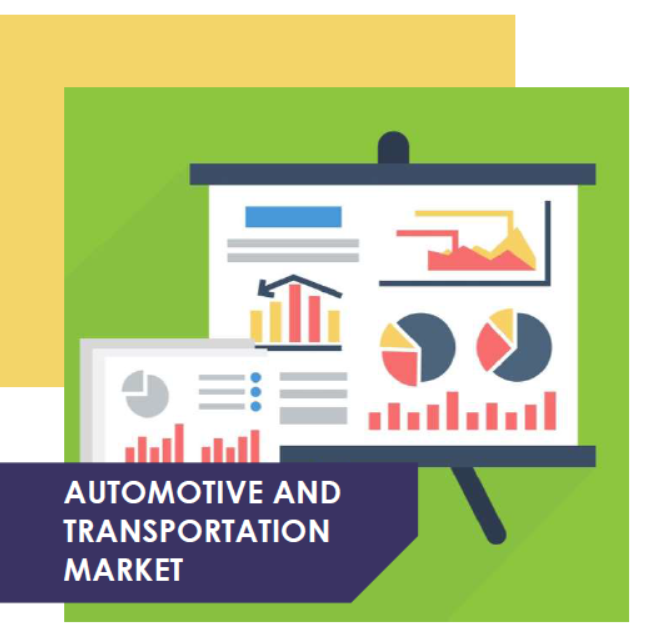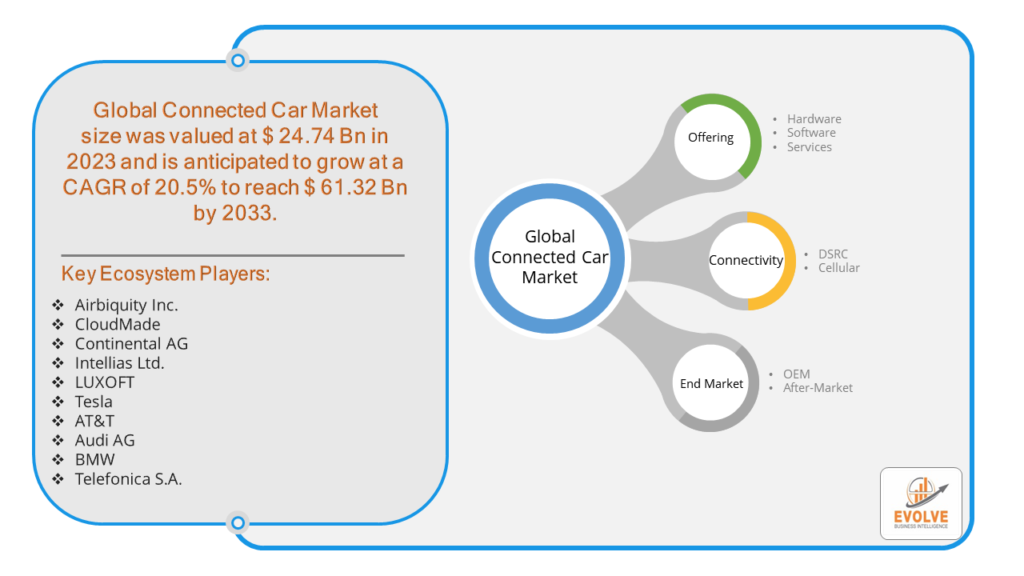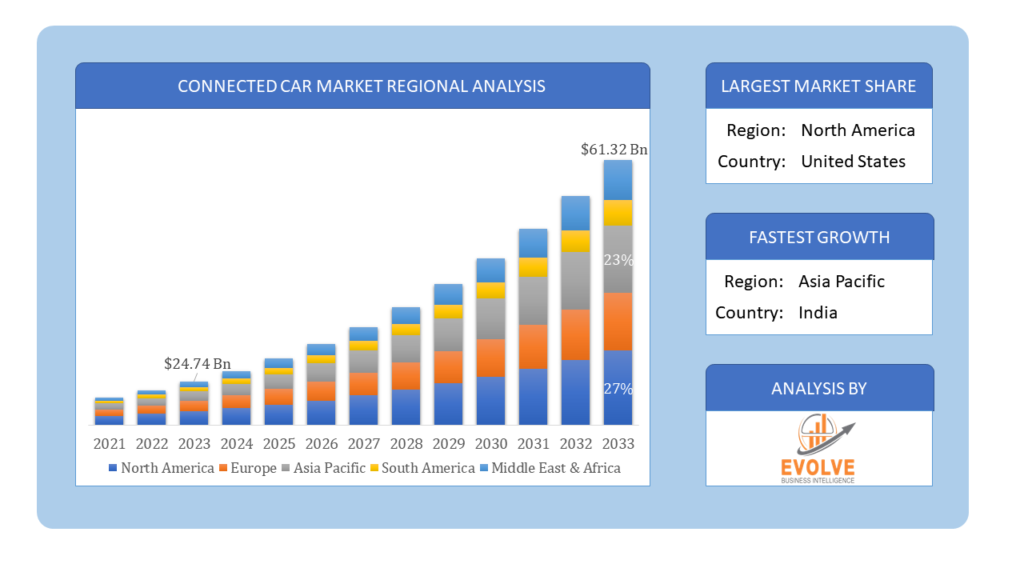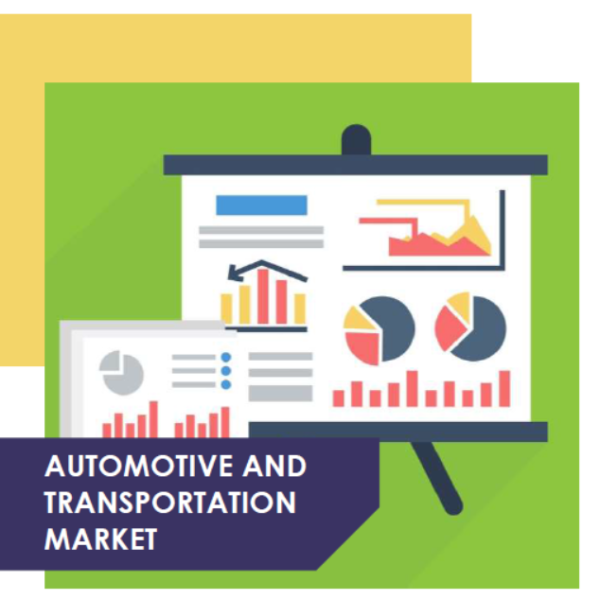Connected Car Market Overview
The Connected Car Market Size is expected to reach USD 61.32 Billion by 2033. The Connected Car Market industry size accounted for USD 24.74 Billion in 2023 and is expected to expand at a compound annual growth rate (CAGR) of 20.5% from 2023 to 2033. The Connected Car Market refers to the industry focused on vehicles that are equipped with internet access and usually also with a wireless local area network (LAN). This allows the cars to share internet access and data with other devices both inside and outside the vehicle.
A connected car is a vehicle equipped with internet connectivity and advanced technologies that allow it to communicate with other vehicles, infrastructure, and the internet. This connectivity enables a wide range of features and services, from entertainment and navigation to safety and autonomous driving capabilities. Overall, the connected car market is experiencing rapid growth and is expected to revolutionize the automotive industry. As technology continues to advance and consumer demand increases, we can anticipate even more innovative and connected vehicles in the future.
Global Connected Car Market Synopsis
The COVID-19 pandemic had a significant impact on the Connected Car Market. The pandemic caused widespread disruptions in global supply chains, affecting the production and delivery of critical components for connected cars, such as semiconductors, sensors, and communication modules. Lockdowns and restrictions led to temporary shutdowns or reduced capacity in automotive manufacturing plants, delaying production schedules and impacting market growth. Research and development activities for new technologies and advancements in connected car systems faced delays due to limited operational capacity and resource allocation shifts towards pandemic-related priorities. The pandemic underscored the importance of connectivity and remote services. Consumers and businesses increasingly valued connected features for enhanced safety, navigation, and remote diagnostics. The pandemic highlighted the need for efficient fleet management solutions. Connected cars equipped with telematics systems became essential for businesses to track and manage their fleets remotely.
Connected Car Market Dynamics
The major factors that have impacted the growth of Connected Car Market are as follows:
Drivers:
Ø Technological Advancements
The integration of Internet of Things (IoT) technology enhances vehicle connectivity, enabling real-time data exchange and improved communication between vehicles and infrastructure. The rollout of 5G networks provides faster and more reliable connectivity, essential for advanced connected car features such as Vehicle-to-Everything (V2X) communication and autonomous driving. Consumers increasingly demand advanced infotainment systems, including streaming services, internet radio, and real-time navigation. Features such as automatic emergency braking, collision detection, and lane-keeping assistance improve vehicle safety and are highly sought after by consumers. The ability to monitor vehicle health and performance remotely is a significant driver, reducing maintenance costs and downtime.
Restraint:
- Perception of High Cost of Implementation and Cybersecurity Concerns
Developing and deploying connected car technologies require significant investments in infrastructure, including 5G networks, IoT platforms, and cybersecurity measures. Retrofitting existing vehicles with connected features or integrating them into new models can increase manufacturing costs, potentially passing higher prices onto consumers. Connected cars collect and transmit large amounts of personal and vehicle data, raising concerns about data privacy and unauthorized access. Vulnerabilities in connected car systems can expose vehicles to cyber attacks, compromising safety and personal information. Addressing cybersecurity risks requires robust protective measures and continuous updates.
Opportunity:
⮚ Advancements in Autonomous Driving
Adoption of Advanced Driver Assistance Systems (ADAS) and autonomous driving technologies, leveraging connected car capabilities for safer and more efficient driving experiences. Opportunities in autonomous delivery vehicles, ride-sharing services, and fleet management solutions. Utilization of vehicle data for personalized services, including customized infotainment options, predictive maintenance alerts, and personalized driving preferences. Potential for automakers and service providers to offer subscription-based services, data-driven insights, and targeted advertising.
Connected Car Market Segment Overview
By Offering
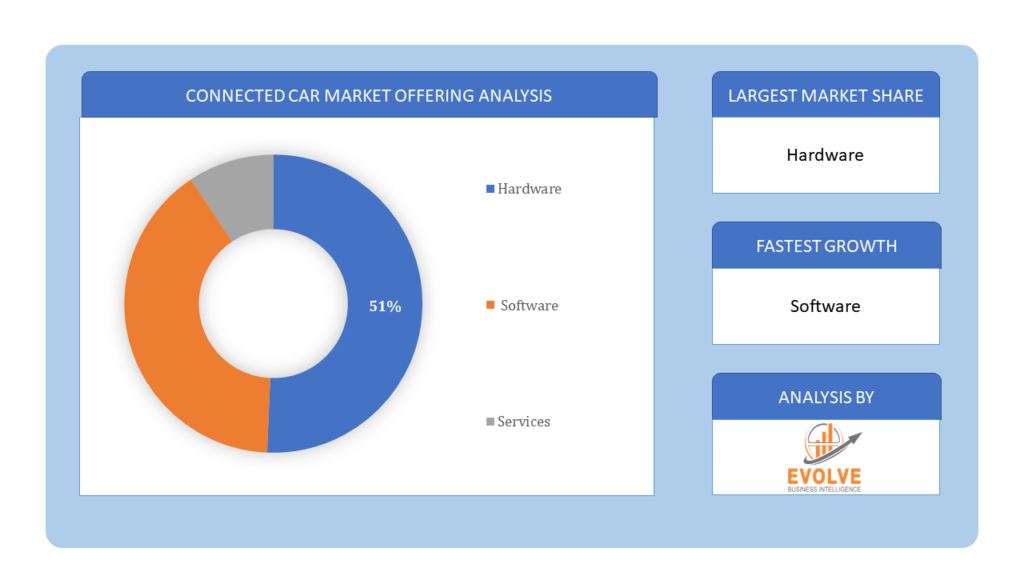 Based on Offering, the market is segmented based on Hardware, Software, Services. The Services segment dominant the market. The Connected Car Market encompasses a wide range of offerings that enhance the functionality, convenience, and user experience of connected vehicles. These services leverage vehicle connectivity to provide real-time data, seamless communication, and various applications aimed at improving safety, efficiency, and entertainment.
Based on Offering, the market is segmented based on Hardware, Software, Services. The Services segment dominant the market. The Connected Car Market encompasses a wide range of offerings that enhance the functionality, convenience, and user experience of connected vehicles. These services leverage vehicle connectivity to provide real-time data, seamless communication, and various applications aimed at improving safety, efficiency, and entertainment.
By Connectivity
Based on Connectivity, the market segment has been divided into the DSRC and Cellular. The Cellular segment dominant the market. This can be attributed to raising popularity of vehicle to everything (V2X) communication that is widely used in autonomous connected vehicle. Cellular connectivity is more popular for V2X communication than DSRC due to factors like widespread deployment of cellular network, high penetration of cellular enable device and flexibility and scalability of cellular system.
By End Market
Based on End Market, the market segment has been divided into the OEM and After-Market. The original equipment manufacturers (OEMs) segment dominant the market. EMs are gaining traction in the connected cars market due to the increased adoption of connected vehicle services. Also, advancement in technology has enabled the customers to choose the connected car’s service in the vehicles, which has eventually led to the growth of the global connected car market.
Global Connected Car Market Regional Analysis
Based on region, the global Connected Car Market has been divided into North America, Europe, Asia-Pacific, the Middle East & Africa, and Latin America. North America is projected to dominate the use of the Connected Car Market followed by the Asia-Pacific and Europe regions.
 Connected Car North America Market
Connected Car North America Market
North America holds a dominant position in the Connected Car Market. North America, particularly the United States, leads in technological advancements and adoption of connected car technologies. Supportive regulatory environment encourages innovation in autonomous driving, V2X communication, and cybersecurity. High market maturity with strong consumer demand for advanced infotainment, safety features, and autonomous driving capabilities.
Connected Car Asia-Pacific Market
The Asia-Pacific region has indeed emerged as the fastest-growing market for the Connected Car Market industry. Rapid urbanization, rising disposable incomes, and government initiatives drive market growth in countries like China, Japan, and South Korea. Strong adoption of electric vehicles and supportive policies promoting EV infrastructure and connectivity. Asia Pacific leads in mobile technology adoption, fostering opportunities for IoT integration and smart mobility solutions.
Competitive Landscape
The global Connected Car Market is highly competitive, with numerous players offering a wide range of software solutions. The competitive landscape is characterized by the presence of established companies, as well as emerging startups and niche players. To increase their market position and attract a wide consumer base, the businesses are employing various strategies, such as product launches, and strategic alliances.
Prominent Players:
- Airbiquity Inc.
- CloudMade
- Continental AG
- Intellias Ltd.
- LUXOFT
- Tesla
- AT&T
- Audi AG
- BMW
- Telefonica S.A.
Key Development
In January 2022, Aptiv PLC announced a next-generation advanced driver-assistance system (ADAS) for driverless and electrified vehicles. Because of Aptiv’s scalable architecture will help to reduce the cost of software-driven automobiles.
In November 2021, Continental introduced a technology solution for highly automated driving, comprising clever software that enables complex autonomous driving. The Next Generation Driving Planner is a cutting-edge software solution that allows for highly autonomous driving starting at Level 3.
Scope of the Report
Global Connected Car Market, by Offering
- Hardware
- Software
- Services
Global Connected Car Market, by Connectivity
- DSRC
- Cellular
Global Connected Car Market, by End Market
- OEM
- After-Market
Global Connected Car Market, by Region
- North America
- US
- Canada
- Mexico
- Europe
- UK
- Germany
- France
- Italy
- Spain
- Benelux
- Nordic
- Rest of Europe
- Asia Pacific
- China
- Japan
- South Korea
- Indonesia
- Austalia
- Malaysia
- India
- Rest of Asia Pacific
- South America
- Brazil
- Argentina
- Rest of South America
- Middle East & Africa
- Saudi Arabia
- UAE
- Egypt
- South Africa
- Rest of Middle East & Africa
| Parameters | Indicators |
|---|---|
| Market Size | 2033: $61.32 Billion |
| CAGR | 20.5% CAGR (2023-2033) |
| Base year | 2022 |
| Forecast Period | 2023-2033 |
| Historical Data | 2021 |
| Report Coverage | Revenue Forecast, Competitive Landscape, Growth Factors, and Trends |
| Key Segmentations | Offering, Connectivity, End Market |
| Geographies Covered | North America, Europe, Asia-Pacific, Latin America, Middle East, Africa |
| Key Vendors | Airbiquity Inc., CloudMade, Continental AG, Intellias Ltd., LUXOFT, Tesla, AT&T, Audi AG, BMW and Telefonica S.A |
| Key Market Opportunities | • Advancements in Autonomous Driving • Data-Driven Services and Personalization |
| Key Market Drivers | • Technological Advancements • Consumer Demand for Enhanced Features |
REPORT CONTENT BRIEF:
- High-level analysis of the current and future Connected Car Market trends and opportunities
- Detailed analysis of current market drivers, restraining factors, and opportunities in the future
- Connected Car Market historical market size for the year 2021, and forecast from 2023 to 2033
- Connected Car Market share analysis at each product level
- Competitor analysis with detailed insight into its product segment, Government & Defense strength, and strategies adopted.
- Identifies key strategies adopted including product launches and developments, mergers and acquisitions, joint ventures, collaborations, and partnerships as well as funding taken and investment done, among others.
- To identify and understand the various factors involved in the global Connected Car Market affected by the pandemic
- To provide a detailed insight into the major companies operating in the market. The profiling will include the Government & Defense health of the company’s past 2-3 years with segmental and regional revenue breakup, product offering, recent developments, SWOT analysis, and key strategies.

